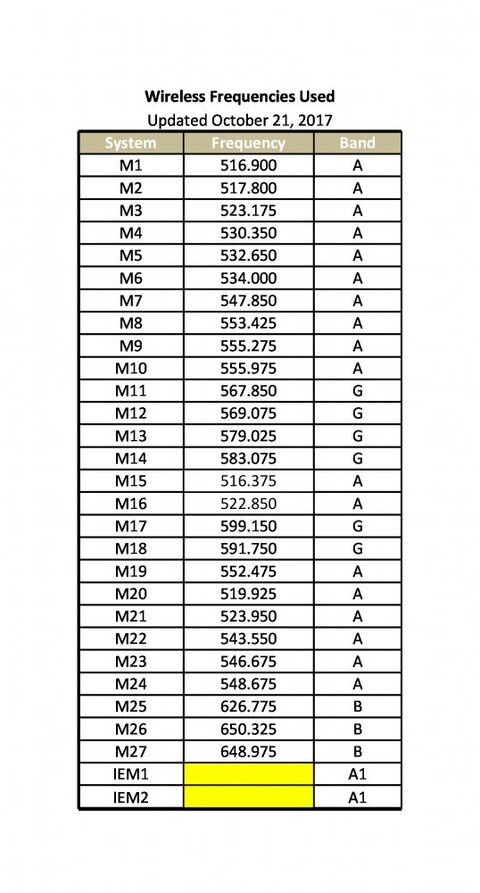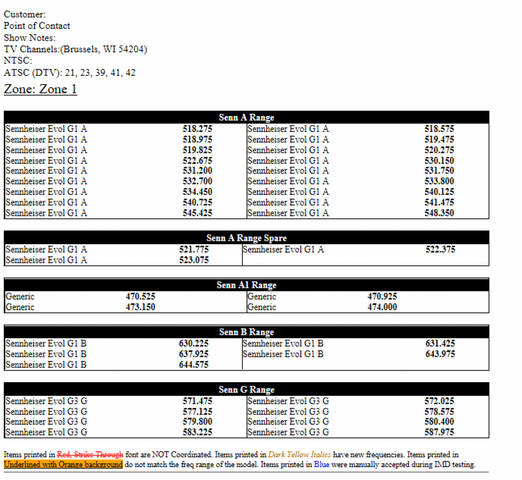@
themuzicman, I've started doing the frequency coordination for my local church and community theater (including while touring with a church production), so I'm still trying to learn as much as I can about this. Being mostly a
Shure shop, I've been using
Shure's WWB6.
My question is how did you do this freq coordination without knowing the brands/models of the microphones? It looks like you assumed that they were all Senn Evol G1s?
IAS has a number of pre-made manufacturer presets built in, additionally I have created many of my own. When the original post asked for A, A1, and G range I know immediately that it's a
Sennheiser pack because
Shure doesn't follow that nomenclature. I also know that the A1 is only available on 300 and 500 series Evolution wireless, so I knew the rest of the wireless is most likely Evolution series as well as most folks try to buy the same series. The A band is NOT the same on the XS (XS it's 548-572) and on the 2000 series they have expanded bands that overlap their other bands and then some which is why you see Evol G1 listed for everything. G1 mics can talk to G3 mics, they are the same, and have the same
companding and all that. I didn't bother going down to G3 because G1 had the bands I needed and it was first alphabetically. I didn't feel like Googling the ranges else I would have just inputed them in a generic
profile.
If you look closely, you'll notice there's just a GENERIC where the A1 band stuff is, I haven't
build a user defined model for them yet. If I encounter them on a gig I'll take the time to enter that (I try to enter all their frequency presets when I make them, so it gets time consuming). When you don't know the
profile of a
microphone, IAS can default to a generic
profile.
Don't most mics vary in their spectral widths between brands/models?
This sentence is perplexing, as I don't know what you mean by spectral width. Most RF microphones have around a 200kHz bandwidth, that's my default when I coordinate. Some can go as low as 125kHz, but it really doesn't matter because the
tracking filters on the input side of your RF receiver aren't going to be going that narrow. It's FM so this is a fixed bandwidth, unlike
The major difference between brands and models are in the
companding circuit, not in the transmission bandwidth (when talking regular analog FM wireless, NOT hybrid digital). That's why I can take a
Sennheiser G3 transmitter and tune it to a 3732 receiver and it makes the right sounds, it just sounds garbagey - evolution series and 2000 series use sennheisers "HDX"
companding, and the 5000 series (including 3732/SK5212/SK5012/SK50) use their "HiDyn"
companding.
This major reason is why manufacturers like Lectrosonics can make the
SSM transmitter work with 3732 - normally it's an uncompanded digital
microphone and fits that signal into the same bandwidth, but the hybrid circuitry has a
companding emulator that emulates the HiDyn
companding and lets it work with the
Sennheiser stuff.
And as far as caring about transmission bandwidth -
spacing between Tx, Rx, and projected intermod products are far more important than the transmission bandwidth of a given wireless
microphone. When coordinating the program is looking at all possible frequency combinations and their resultant intermod products. You need to space them appropriately far away from your transmitter so things don't get stepped on.




